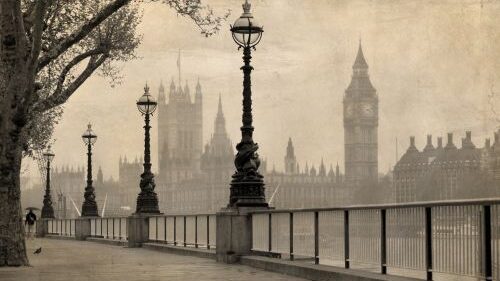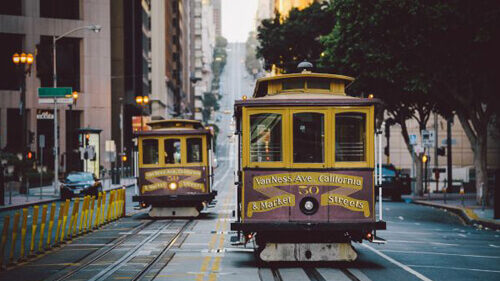Atul Singh’s reminiscences of London in his FO° Wednesday newsletter on November 29, 2023, were just wonderful. I felt I was walking next to him. He asked, “What makes London special: history, beauty or community?” For me, it is all of these, plus some indefinable “glue” that binds them all into a unique culture.
Am I a Londoner?
Since my “yoof” (youth) in the 1960s, I lived, studied and worked in London for nearly 40 years. Yet, even though I feel more attuned to London than any other place in Britain, I cannot honestly call myself a true Londoner. To acquire that distinction would require that I had been born and bred there — not necessarily in the East End “within the sound of Bow Bells” (an old phrase referring to the bells rung at the church of St Mary-le-Bow). That would make me a traditional Cockney. But no, at least somewhere within the 32 boroughs of Inner and Greater London or within the City of London, the smallest and oldest local authority right in the center of the metropolis.
Still, I can join in with fellow patrons in one of the traditional pubs (short for “public houses” or licensed drinking establishments) in singing “Maybe it’s because I’m a Londoner” and other ditties (short, simple songs), especially if it’s backed by an old Joanna (piano). Or, I can join in traditional pub sports such as darts, dominoes, skittles or cribbage. Nowadays, one has to seek out such traditional nightspots, since most metropolitan pubs cater for fast-moving modernity and youth, and they eschew parochial signaling.
Nevertheless, the pub tradition doggedly remains. An old college professor once advised me that the role of the pub was not to get the patrons inebriated but rather to provide social affirmation. The sociologist Victor Turner referred to this phenomenon as “social liminality and communitas.” A pub is a congenial place for social cohesion — what the Germans would call Zusammenhalt — where patrons rub shoulders and engage with friends, acquaintances and complete strangers from all walks of life and hopefully leave feeling moderately uplifted. Long before psychiatrists and antidepressant medications, the publican and fellow patrons provided a ready sounding board for lay diagnosis, problem solving and support.
Then, there is the distinctive London lingo or patois, a diluted form of Pure Cockney with terms and rhyming slang such as “apples-and-pears” (stairs), “butcher’s” (short for “butcher’s hook,” meaning “look”), “cor-blimey” (may God blind me), “guv” (boss, governor), “geezer” (a man), “bloke” (a man), “wedge” (sizable bundle of banknotes), “sov” (£1, short for “sovereign,” a gold coin), “pony” (£25) and “monkey” (£500).
Given my name, Alan, how could I ever forget the expression “Don’t get your Alans in a twist”? Alan Whicker was a well-known BBC television journalist from the 1950s to 80s. Rhyming with Whicker are “knickers” (underpants). Since “getting one’s knickers in a twist” means getting unduly frustrated and annoyed as a result of one’s own actions failing to solve a minor problem, the Cockney expression’s meaning becomes all too clear.
No one today, except perhaps a few diehard Cockney “Pearly Kings and Queens,” stuffs their colloquial speech with such language like Dick Van Dyke did in the 1964 film Mary Poppins. Nonetheless, many Londoners of all social and educational strata do drop the odd Cockney expression into conversations for effect, usually to convey an emphasis, exasperation or absurdity.
In the past 50 years or so, London itself has continued to evolve and change, as it has done since at least the time of Roman Londinium. Encircled by the M25 motorway, the Greater London population is now somewhere between 10 million and 14.4 million, depending on boundary definitions, with a multi-ethnic polyglot character. Ever since Roman times, London has been a magnet for foreign immigrants of all kinds — invaders, traders, entrepreneurs, students, refugees and so on.
Moreover, starting in the 1960s, the population who work in London has continued to spread out across the surrounding Home Counties and beyond, often seeking more affordable housing. The government encouraged this migration as part of post-World War II reconstruction and development and to control urban sprawl. Eight “New Towns” were designated within a 50-mile radius of London alone to accommodate London’s population overspill, but many more existing towns have also continued to attract Londoners.
Nowadays, commuting 200 miles into London every day is not uncommon. A gradual modification of spoken English has also accompanied this population spread, so that within a 100-mile radius from Central London it has become “averaged out”; a mild Cockney-ish accent. Even in the posh spoken English of lawyers and university dons, one can often now detect the odd glottal stop or disappearing “T.”
This new spoken English is called Estuary English, alluding to its prevalence in the populations spread out across London and counties on both sides of the River Thames and the Thames Estuary. I am an exponent of the genre, although I do check myself when conversing with non-Estuary speakers. Pronouncing a final letter “L” as a “W” (e.g. we-w instead of well), or not enunciating a final “ow” (e.g. tomorrah instead of tomorrow), or omitting the letter “T” (e.g. be-uh instead of better) may convey laziness or poor education.
Feeling personally connected
In many ways, my own ancestry reflects the post-Roman history of London and Britain generally: a melange of Celtic, British, Norman, Scandinavian and Anglo-Saxon DNA. The surname Waring does not appear in British documents until after 1067; it first crops up as Warin, Warenger, Warrene and Guerri in the Domesday Book, William the Conqueror’s infamous taxation register of all real estate and other property ownership, completed in 1086. Of ten Warins listed in the Domesday Book, none had owned properties in Britain before 1066, but by 1086, some owned dozens of properties.
Other Norman variants of Waring include Guerin, meaning guard or protector. The Normans themselves were of mixed descent from both Romano-Celts, Franks and seaborne invaders from North Germany, Denmark and Norway. The Waring name via the Normans may also be related to the German Wahrung, also meaning guard or protector.
In the late 1970s and early 80s, I worked as a Principal Officer at the Corporation of the City of London. This local authority was formed in the 12th century. It covered the original Londinium of the Roman era. The City further developed in Saxon times, and it successfully defended itself against Viking invaders, but not the Norman takeover of London in 1067. In 2006, the word Corporation was dropped from its branding and public-facing name, becoming just the City of London — but for me, it will always be the City Corporation.
My office was in the oldest part of the Guildhall over the ceremonial main entrance doors into the Guildhall proper, where the many state banquets are held. There are many guildhalls across Britain, the name likely stemming from the Saxon “gild” or “geld” (money) and the place (“hall”) where local taxes and dues were paid. But this Guildhall, originating in 1411, is the most famous and prestigious. My office window was the perfect reconnaissance point to observe all the comings and goings of staff, visitors and dignitaries as they crossed the Guildhall Yard below.
Down in the Guildhall vaults, the Museum of London (run by the Corporation at its own site at the junction of London Wall and Aldersgate Street) keeps City records from all the way back in Saxon times, including the original freedom charter that William the Conqueror granted the city elders in 1067. This was a way of buying their loyalty and deterring them from opposing his takeover after King Harold II lost Battle of Hastings in 1066.
Quirkiness and hidden talents
The City has retained its ancient legislature and administration (The City Aldermen, the Common Councillors, the Court of Common Council, the Town Clerk) and the over 100 ancient livery companies and trades guilds whose titles all start with “Worshipful Company of…” (examples include “Fishmongers”, “Haberdashers”, “Salters”, “Vintners”, “Wax Chandlers”, and “Tobacco Pipemakers and Tobacco Blenders”). Freemen of the City are entitled to join a livery company. By the way, since 1872, the term “freeman” has applied equally to men and women!
The livery companies elect the Aldermen, whereas the eligible resident and business population of the City elects the Common Councillors. The quaint livery companies, many of whose actual trades died out centuries ago, facilitate the interests of big business corporations and their bosses who operate in the so-called “Square Mile,” which is the nation’s financial hub. It’s all about power, privilege, contacts and doing business.
The term “alderman” in British administrative law evolved from Anglo-Saxon times and probably stems from the North Germanic term of “Æltermann” (elder), a term for a person recognized for their age and wisdom. It was still part of local authority structures throughout Britain when I was a boy, but largely disappeared as a result of local government streamlining in the 1960s — yet not in the City of London. Similarly, the chief executive of a local council, big or small, was the Town Clerk before they all became Chief Executives — but not in the City of London. These quaint historical relics remain unchanged.
The Corporation also has a surprisingly wide range of responsibilities. For example, it manages and maintains the Tower Bridge, operates several major iconic markets (such as Smithfield meat market and Billingsgate fish market), runs several elite schools including the Guildhall School of Music and Drama and the two City of London Schools (one for boys, one for girls), manages “for the people of London” the whole of Epping Forest (an ancient hunting forest just inside the region of Essex) and curiously runs the Animal Quarantine Service at Heathrow Airport. It also provides and administers the Central Criminal Court at the Old Bailey and owns the freehold (the property and the land that it is built on) on vast tracts of prime commercial property across London.
A sense of history, continuity and loyalty
My own sense of history, continuity and loyalty to the Crown grew during my time in the City and was cemented by two particular privileges that I was granted. One was being allowed to see the original City freedom charter, a very rare honor. The other was being granted Freedom of the City, the honor that allows a person to call themselves a freeman. One archaic privilege of being a freeman was that, in past centuries, I could have run my sheep and livestock through the City streets and traded them at fairs and markets, all without paying any tithes or taxes. Most of these anachronistic privileges are long gone, and most contemporary privileges are more symbolic than practical.
The City Chamberlain (complete with fur stole and regalia!) officiates the Freedom investiture of an individual in his own court. The first recorded instance of this ceremony took place in 1237. During my own, I read out a special oath of allegiance to the monarch (then Queen Elizabeth II) from “the little red book” entitled Rules for the Conduct of Life (there are 36 of these rules). Although written in slightly archaic English, it is packed with both common sense and guidance on steering one’s life with honesty, integrity, honor and being ever mindful of one’s own limitations and the rights of others.
Perhaps it should be required reading for all politicians, corporate executives and public officials!
[Will Sherriff edited this piece.]
The views expressed in this article are the author’s own and do not necessarily reflect Fair Observer’s editorial policy.
Support Fair Observer
We rely on your support for our independence, diversity and quality.
For more than 10 years, Fair Observer has been free, fair and independent. No billionaire owns us, no advertisers control us. We are a reader-supported nonprofit. Unlike many other publications, we keep our content free for readers regardless of where they live or whether they can afford to pay. We have no paywalls and no ads.
In the post-truth era of fake news, echo chambers and filter bubbles, we publish a plurality of perspectives from around the world. Anyone can publish with us, but everyone goes through a rigorous editorial process. So, you get fact-checked, well-reasoned content instead of noise.
We publish 3,000+ voices from 90+ countries. We also conduct education and training programs
on subjects ranging from digital media and journalism to writing and critical thinking. This
doesn’t come cheap. Servers, editors, trainers and web developers cost
money.
Please consider supporting us on a regular basis as a recurring donor or a
sustaining member.
Will you support FO’s journalism?
We rely on your support for our independence, diversity and quality.








Comment